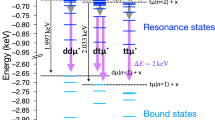Abstract
Preliminary results are reported for an experiment at TRIUMF where a time-of-flight technique was tested for measuring the energy dependence of the rate for muon-catalyzed dt fusion. Muonic tritium atoms were created following transfer of negative muons from muonic protium in a layer of solid hydrogen (protium) containing a small fraction of tritium. The atoms escaped from the solid layer via the Ramsauer-Townsend mechanism, traversed a drift region of 18 mm, and then struck an adjacent layer of deuterium, where the muonic atom could form a molecular system. The time of detection of a fusion product (neutron or alpha) following muon arrival is dependent upon the energy of the muonic tritium atom as it traverses the drift region. By comparison of the time distribution of fusion events with a prediction based on the theoretical energy dependence of the rate, the strength of resonant formation can in principle be determined. The results extracted so far are discussed and the limitations of the method are examined.
Similar content being viewed by others
References
P.E. Knowles et al., these proceedings (Hyp. Int. 101/102 (1996) 21).
D.L. Denim et al., these proceedings (Hyp. Int. 101/102 (1996) 13).
F. Mulhauser et al., these proceedings (Hyp. Int. 101/102 (1996) 229).
R. Jacot-Guillarmod et al., these proceedings (Hyp. Int. 101/102 (1996) 239).
P. Strasser et al., these proceedings (Hyp. Int. 101/102 (1996) 539).
M.C. Fujiwara et al., these proceedings (Hyp. Int. 101 /102 (1996) 613).
R. Jacot-Guillarmod et al., these proceedings (Hyp. Int. 101 /102 (1996) 563).
V.E. Markushin, preprint PSI-PR-94-38 (PSI, Villigen, 1994).
V.E. Markushin, these proceedings (Hyp. Int. 101/102 (1996) 155).
J. Wozniak et al., these proceedings (Hyp. Int. 101/102 (1996) 573).
M.P. Faifman and L.I. Ponomarev, Phys. Lett. B 265 (1991) 201.
M.P. Faifman et al., these proceedings (Hyp. Int. 101/102 (1996) 179).
Yu.V. Petrov et al., Phys. Lett. B 34 (1994) 266.
M. Jeitler et al., Phys. Rev. A 51 (1995) 2881.
M.C. Fujiwara et al., these proceedings; see also: M.C. Fujiwara, M.A.Sc. Thesis (University of British Columbia, 1994).
P.E. Knowles et al., Hyp. Int. 82 (1993) 521; Nucl. Instr. Meth. A 368 (1996)604.
A. Adamczak et al., report WMM 94-1 (College of William and Mary, Williamsburg, 1994).
B.M. Forster et al., Hyp. Int. 65 (1990) 1007.
G.M. Marshall et al., in:Proc. Int. Symp. Muon Catalyzed Fusion, µCF-89, ed. J.D. Davies, report RAL-90-022 (Rutherford Appleton Laboratory, 1990).
Author information
Authors and Affiliations
Rights and permissions
About this article
Cite this article
Marshall, G.M., Adamczak, A., Bailey, J.M. et al. Time-of-flight measurement of resonant molecular formation in muon-catalyzed dt fusion. Hyperfine Interact 101, 47–55 (1996). https://doi.org/10.1007/BF02227605
Issue Date:
DOI: https://doi.org/10.1007/BF02227605




